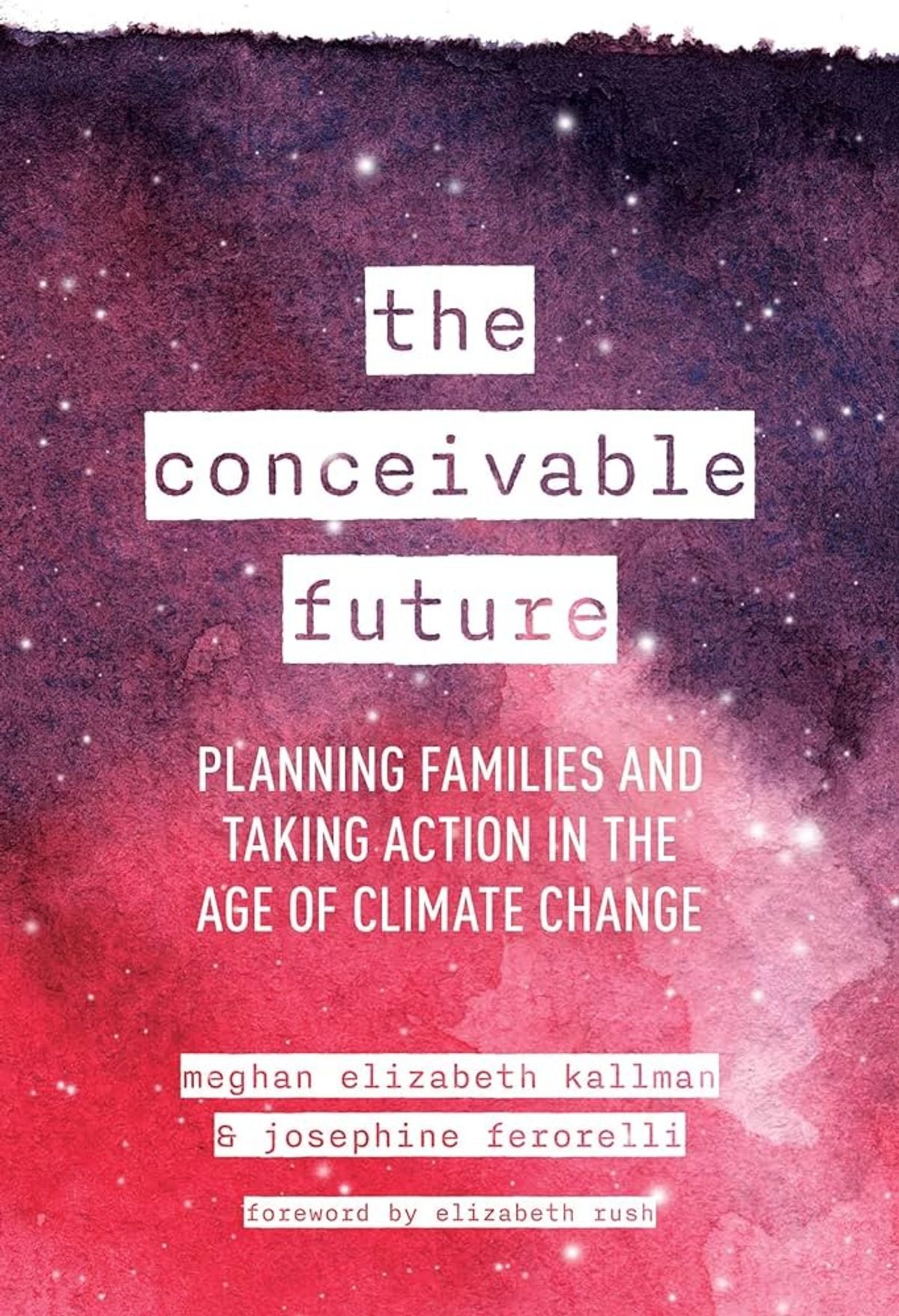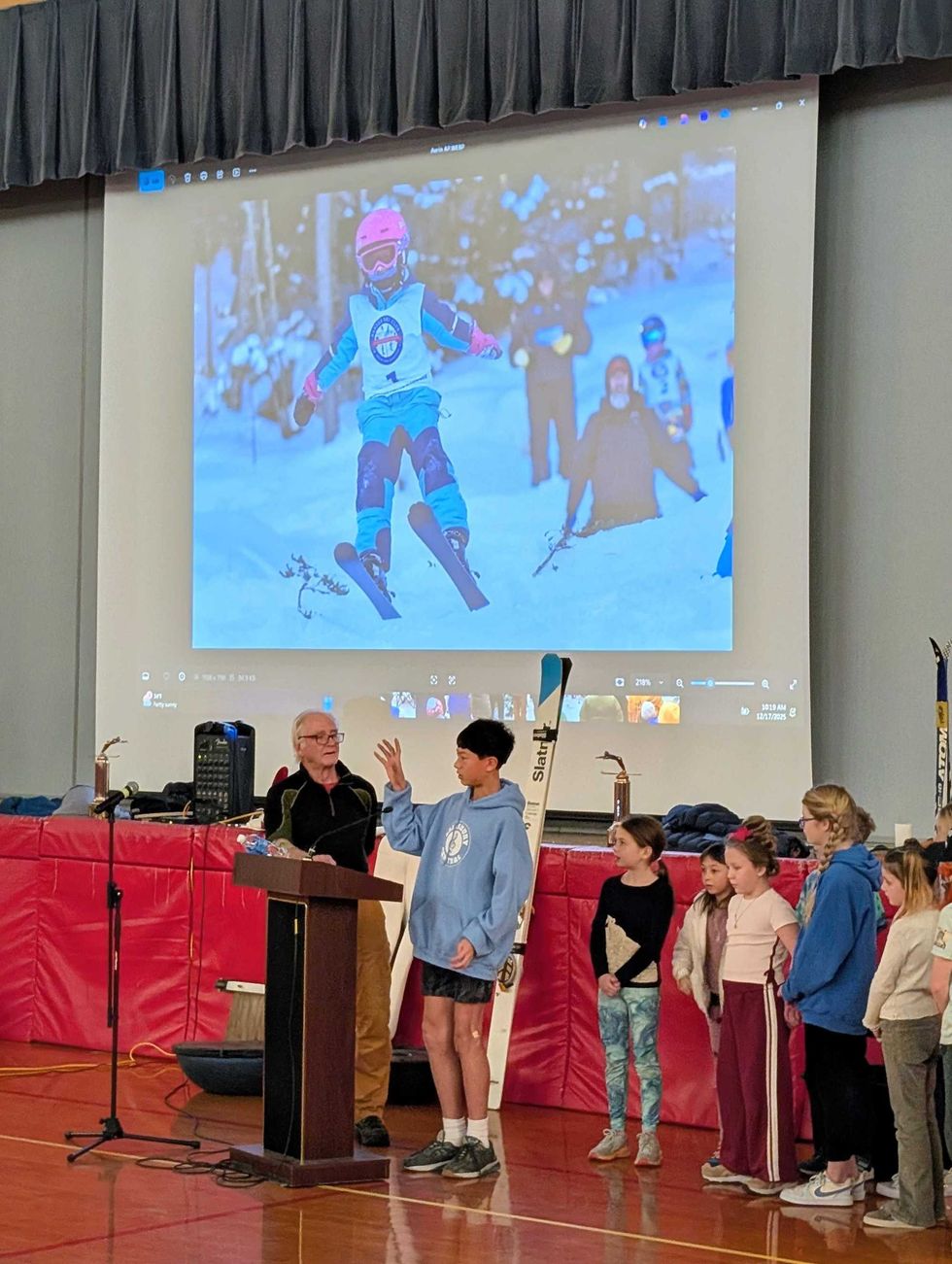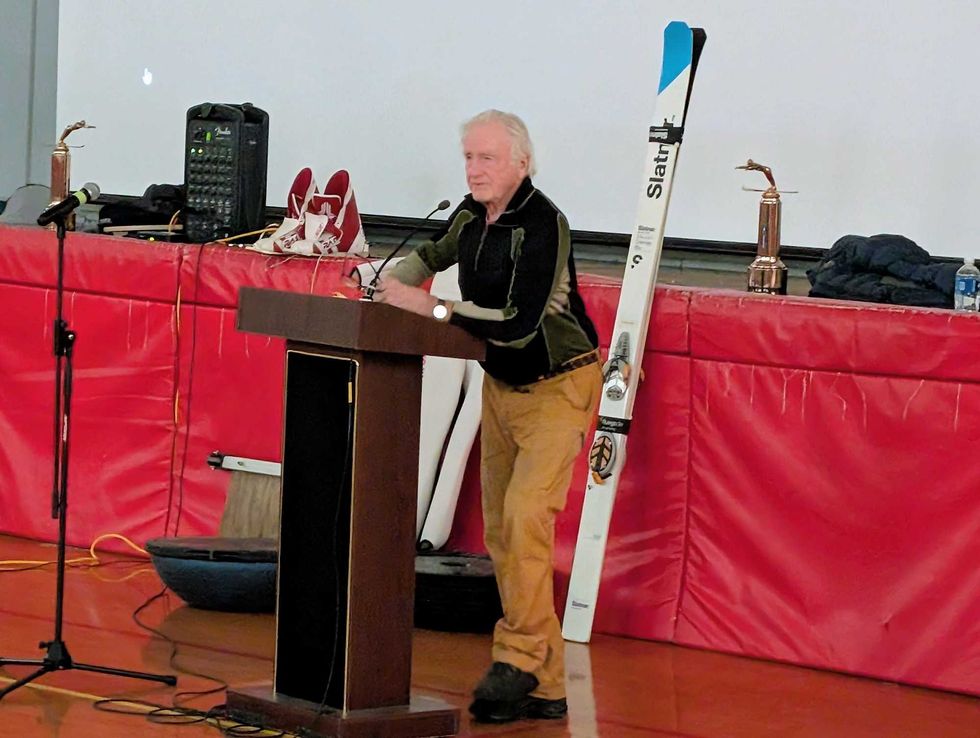Millennials rethink parenthood amidst climate crisis

Rowman and Littlefield Publishers

CORNWALL — Should potential parents fear the future? Yes and no.
A new book released this February from Rowman and Littlefield Publishers, “The Conceivable Future: Planning Families and Taking Action in the Age of Climate Change,” tackles reproductive planning from the point of view of millennial couples — ages 28 to 43 — contemplating bringing new life into an environmentally uncertain world. Written by Meghan Elizabeth Kallman, a member of the Rhode Island Senate from the 15th district, and Josephine Ferorelli, a writer and climate activist, the two met ten years ago at a concert. There they bonded over their views on how inequality, heat, fossil fuel pollution and other eco-concerns intersect with reproduction.
At Cornwall Library on Friday night, Feb. 9, Kallman and Ferorelli celebrated the launch of their book and discussed challenging rhetoric on population control as a remedy for climate change and messaging that burdens those with the least power with the responsibility of solving the Earth’s problems.
So what are millennials’ significant concerns regarding family planning and climate change, and is anxiety around global warming actually halting childbirth for this generation in their prime childbearing years?
As Business Insider, among several other publications, reported recently, “Since 1950, the worldwide fertility rate dropped from an average of 4.7 children to 2.4 children. U.S. fertility rates peaked in 2007 before declining in 2008 during the Great Recession, and they accelerated their slump when the pandemic hit. Last year, a Centers for Disease Control and Prevention report found that the U.S. birth rate fell by 4% from 2019 to 2020, the sharpest single-year decline in almost 50 years, and the lowest number of births since 1979.”
It’s harder to pinpoint this data to one specific cause — recent decades have seen more significant access to birth control, increased student debt in the face of an exuberant child care affordability crisis — studies show numbers ranging from $20,000 to $50,000 for the child’s first year of life — and more career and workforce opportunities for women which might be hindered by maternity leave. As the U.S. Census Bureau reported, more women are delaying marriage, with the median age for an American woman’s first wedding increasing from age 20 in 1950 to age 28 in 2023.
“So much of the discourse around the climate crisis says we must avert disaster for the children,” said Ferorelli. “When we love our children, our students, our siblings, our [nieces and nephews], our young friends, we understand it’s visceral. But in an equally true way, we are the children. [Millennials] were all born into this crisis.”
She addressed that the focus on reproductive planning in the book was a way to open a broader conversation on eco-activism, specifically geared toward women, whose bodies are centered in conversations around population control or decline. “For us, reproduction isn’t the whole story, but it reveals the story’s heart. Focusing on reproduction in the context of climate change exposes the same unjust core that motivates many other social movements. It shows what’s at issue for all of us. As the climate changes, all stakes are raised. Some non-parents feel that their commitment to climate work would foreclose the possibility of parenting. At the same time, parents have described feeling locked out of activism or struggling to stay involved because time and money are short, activist spaces do not often accommodate children, or they find themselves dismissed as mere mothers, not meeting the conventions of radicalism.”
As Bryan Walsh wrote for Vox last year, “While it’s true that a child born today will be responsible for adding more carbon into the atmosphere…In a rich country like the U.S., a baby born today will emit less CO2 on average over their lifetime than their parents did; according to the International Energy Agency, if the world achieves carbon neutrality by 2050, the carbon footprint of those New Year’s babies could be ten times smaller than that of their grandparents.”
Using an extreme angle, Kallman pointed out that forgoing childbirth for the sole sake of reducing harm to the planet is as radical and unnecessary as suicide: “Rather than identifying the bigger forces acting on our lives, the innate climate problem of scale, that we’re tiny and helpless, is aggregated by isolation. But this cognitive dissonance is paralyzing and demoralizing. So, if you follow the personal footprint reduction strategy to its logical end, the most effective action you can take for the planet alone is to kill yourself now. And we don’t say this to be callous or macabre. The tragic reality is that some people who are no longer able to bear this devastation have ended their lives. But the example proves the point. Suicide doesn’t solve the climate crisis. One person fewer on the planet does not fix systemic injustices. So we can move beyond the view that our individual consumer or reproductive choices are the most meaningful contribution to the fight against climate consequences.”
Students of Salisbury Central School watch ski jumpers soar during an assembly with Salisbury Winter Sports Association Wednesday, Dec. 17.
SALISBURY — Representatives of Salisbury Winter Sports Association gave a presentation at Salisbury Central School Wednesday, Dec. 17.
Former U.S. Olympic coach Larry Stone explained the fundamentals of the unique sport of ski jumping and its long history in Salisbury, where he learned to jump.
“When I was growing up here there were actually eight ski jumps just in this town in addition to the three down at Satre Hill,” he said. He noted that this winter will be the 100th year of Jumpfest at Satre Hill, named for the Satre brothers who moved from Norway in the 1920s. “They brought their sport with them and the first ski jump was actually when one of the Satres skied off of a barn roof in the center of Salisbury to show people how to do it.”
Mentioning the upcoming Winter Olympics in Cortina/Milan, Italy, Stone spoke of legendary Salisbury ski jumper Roy Sherwood who competed at Cortina in the 1956 Olympics.

Students at SCS saw videos of ski jumpers training and competing. Stone invited up students who had jumped at Satre Hill and 14 stepped forward.
One student was Aerin Sheil, who was asked what it feels like to jump: “It kind of feels like you’re flying. It’s a really good feeling.”
Gus Tripler, another student, said, “It’s like you’re suspended in the air and can see everything.”
He said his record distance of 18 meters was set in Vermont.
The student remarks gave way to closing comments that emphasized the school’s partnership with the Salisbury Winter Sports Association.
“Our partnership with SWSA is one of the most incredible things about Salisbury Central School,” Principal John Conklin said as he closed the assembly. He encouraged the students to attend Jumpfest Feb. 6 to 8.

The Community Closet at HVRHS is open for students to take clothes for any reason during the school day.
What started with one unexpected donation of clothes has grown into a quietly impactful resource for all students at HVRHS: the Community Closet. Now located in a spacious area above the cafeteria, the closet offers free clothing to any student for any reason.
The idea began a few years ago when a community member reached out to the former superintendent wondering if anyone at the school could benefit from used clothing that would otherwise go to waste. The superintendent then got in contact with Rachel Novak, the school social worker. “Once I had all those bags of clothes in my room, I was like, ‘I should put this in a space,’” Novak said. Her simple idea eventually became a full-sized closet accessible to all students.
From the beginning, Novak envisioned the closet as an inclusive space. “It’s open to anybody, it’s not just based on economic needs,” she said. Sustainability also plays a role. “Thinking about the environment, some students like to thrift and just get clothes that way,” Novak said.
After the initial donation, contributions continued to grow. “I reached out to our staff members and faculty,” Novak said. The most consistent donations come from the faculty at HVRHS and a few community members who learned about the closet. Finding teenage-appropriate clothes has been a challenge. “I get a lot of donations that are nice, but I don’t think teenagers would want to wear them,” Novak said.
Another ongoing obstacle has been awareness. Many students don’t know the closet exists at all. “That’s been the hard part,” Novak said. “Getting it out to the wider community of the school.” Novak is looking for students and staff to spread the word. “It helps because our school nurse knows and other faculty members,” she said. “When they know a student needs something, they just bring them up.”
Looking ahead, she hopes to promote the space more actively. “When we come back from this break, I do plan to … get fliers and all that up and going,” Novak said. There may even be an upcoming expansion — she has discussed the possibility of turning part of the area into a food pantry. “That would be more of a need-based system for students,” she said. “But right now, promoting it is where I’m at.”
The Community Closet is well-stocked currently. “Just because of the amount of clothes I have, I’m not accepting any more donations until I clear some stuff out,” Novak said. She is still willing to make room for more fashionable, teen-friendly items donated by students. “That way I’ll have more teenager approved clothes.”
Above all, she wants students to know that no one is limited to using the space. “Sometimes there’s a stigma around it … like, ‘I don’t need help. I don’t want to take away from anybody else that may need it,’” Novak said. Due to the amount of clothes, students should feel welcome to use the closet for any reason. Some students even grab items last minute for sports and activities. “It’s important for kids to know it’s for everyone.”
Whether a student wants to thrift clothes sustainably, forgot to pack clothes for an after-school practice, or is in need of a new outfit, the Community Closet is a resource for all.
Sophomore Eliana Lang enjoys her Housy Shack cookie.
Now in its second year, the Housy Shack is a hit among students. The special education department-run store that sells warm cookies, drinks and other snacks to students and teachers draws people to a room in the back hallway every time it’s open.
The smell of warm cookies welcomes visitors to the store with snacks, drinks and even Housy merchandise for sale. The cookies are definitely the favorite, sometimes lines go out the door to get one before they sell out.
The cookies are so popular that the store had to increase prices from 50 cents to a dollar and implement a four cookie per person maximum. The Shack sells about 40-100 cookies per day and has about 20-60 HVRHS customers visiting per day.
Julie Browning and Heather Strid, two of the HVRHS faculty members that help run the Shack, said their goal was to create real-world job experiences as well as real-world shopping experiences for students at HVRHS. “Learning the skills to work in the world can be taught in a classroom, but the lessons are more meaningful and valuable when they are applied in real work situations, which is what we create through the school store,” Browning said.
The original purpose for the store seems to be working, as several students are learning important skills. Students said the store taught them skills like counting money, checking inventory and cleanliness along with social skills and customer service that could help in the professional world after high school.

As the store quickly became a hit, organizers were faced with the challenge of finding funding. “When we started planning to start the school store two years ago we needed money to buy equipment, supplies and food to start it up but were not sure how to get it,” Browning said. “Mrs. Strid came up with the idea of applying for a grant from the 21st Century Fund to help us get started and they were so generous.” That grant has been crucial to the success and growth of the school store.
Not only does the Housy Shack benefit the special education department, students said it fosters a sense of community throughout the school. “School store cookies are my favorite thing ever. They brighten up my day,” said Eliana Lang, a sophomore at HVRHS. Dayana, one of the student staffers at the Housy Shack, said her favorite part of working in the school store is when students come in to make purchases. She enjoys talking to them and ringing up their orders on the cash register. The Housy Shack brings people together and offers the opportunity for students to connect with each other.
As the school year continues, the members of the school store look forward to expanding their inventory by creating and selling a variety of Housy merchandise — t-shirts, sweatshirts, water bottles, and more. “I have had several students put in requests for certain hats, key chains, etc. … so there will be more of that to come,” Browning said. Last school year, profits were all invested back into the school store. “This year we are hoping to make more of a profit and will look to use the money that we make for field trips, outings as well as opportunities to donate and give back to the community,” Browning said. They also would like to use the school store to fundraise for other causes. “Right now we are collecting donations for The Little Guild Animal Shelter, so if anyone has pet supplies they would like to donate please drop them off in exchange for a cookie,” Browning said.